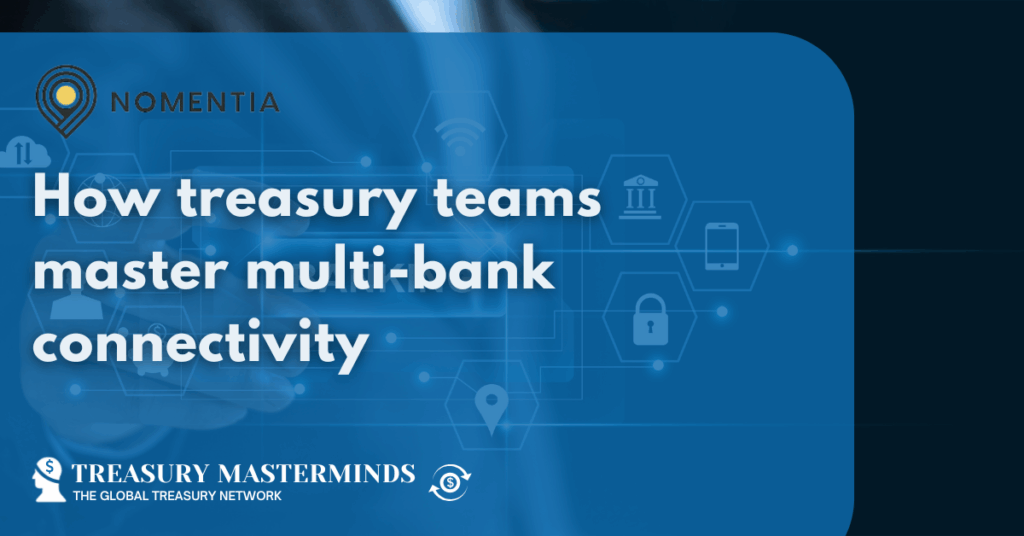
7 Tricks of the Trade to Enhance Your Cash Reconciliation Process
This article is written by Treasury4 Treasury professionals know that cash reconciliation is an essential part of cash flow management for any organization. It shows the company’s cash position, identifies errors or fraud, and allows management to make informed, strategic decisions based on the most up-to-date information. Unfortunately, the cash reconciliation process comes with several common hurdles that CFOs and treasurers must constantly deal with. And if you’re not careful, these issues can quickly snowball into larger financial risks. Today, we’ll share several actionable tips to improve your cash reconciliation process. First, let’s look at the most common pain points of the cash reconciliation process—and how they can create even larger problems. Key Challenges in Cash Reconciliation Cash reconciliation is the process of making sure your company’s financial records match up with actual bank balances. And it can come with several challenges, including: The good news is that there are strategies to overcome these challenges. Let’s look at some of the most effective ones. 1. Use Automation Automating your cash reconciliation is one of the most effective ways to optimize the process. It minimizes the manual workload, reduces errors, and accelerates the entire workflow. Here’s how automation can transform your process: Treasury4’s automation features provide near real-time visibility into your cash position, ensuring better accuracy and freeing up your finance team to focus on more important duties. Scalability is another key feature of Treasury4. As your business grows, so do your financial transactions. With a scalable solution, your reconciliation process evolves effortlessly—and automatically—alongside your operations. 2. Create Clear Guidelines Inconsistent practices across departments can lead to confusion and errors in your reconciliation process. Consider creating a step-by-step guide that clearly defines the reconciliation process. Include which systems to use, how to verify transactions, and how to resolve discrepancies. Make sure this guide is used by any team member involved in the process. Treasury4 can help standardize your cash reconciliation process by enabling custom workflows so that everyone follows the same procedures. Having a structured, repeatable process ensures consistency and reduces the risk of errors or discrepancies. 3. Use Templates to Ensure Nothing Is Overlooked Using standardized templates for various parts of the reconciliation process ensures every step is being carried out properly. Types of templates to consider: Treasury4’s customizable templates allow you to create tailored solutions for your organization’s unique needs, ensuring every task is completed to satisfaction. 4. Move to Daily or Weekly Reconciliations Monthly reconciliations can create a backlog of discrepancies that pile up over time. By moving to daily or weekly reconciliations, you can catch errors early and resolve them before they grow into larger issues. Keeping your accounts reconciled more often reduces stress (and bottlenecking) at the end of the month. Treasury4’s user-friendly interface improves the reconciliation process, making it easy to manage as often as you want. 5. Monitor Key Accounts Closely Not all accounts require the same level of attention. Make sure you give particular focus to accounts with high transaction volumes or frequent fluctuations. This way, you can make sure they’re reconciled accurately and efficiently. Treasury4 offers advanced reporting capabilities that allow you to set up custom alerts and track key accounts in real time. By watching these accounts closely, you can find issues before they escalate. Analyze Discrepancies and Trends to Refine Your Process Discrepancies will inevitably arise, but tracking and analyzing these issues over time can help you spot patterns, identify root causes, and implement preventive measures. Here are some best practices for analyzing discrepancies: With Treasury4’s detailed, customizable reporting features, finance teams can track discrepancies, show recurring issues, and gain valuable insights into their root causes. 6. Analyze Discrepancies and Trends to Refine Your Process Discrepancies will inevitably arise, but tracking and analyzing these issues over time can help you spot patterns, identify root causes, and implement preventive measures. Here are some best practices for analyzing discrepancies: With Treasury4’s detailed, customizable reporting features, finance teams can track discrepancies, show recurring issues, and gain valuable insights into their root causes. 7. Use Accurate Documentation to Simplify Audits Documenting every step of the reconciliation process is crucial—both for day-to-day operations and to be prepared for audits. For one thing, it enhances transparency and allows stakeholders to feel confident in the data. For another, properly documenting discrepancies—including their root causes and how they were resolved—makes audits more efficient and ensures compliance with regulatory requirements. Also Read Join our Treasury Community Treasury Masterminds is a community of professionals working in treasury management or those interested in learning more about various topics related to treasury management, including cash management, foreign exchange management, and payments. To register and connect with Treasury professionals, click [HERE] or fill out the form below. Notice: JavaScript is required for this content.

AI in Treasury: Real Use Case for Faster Close & Better Forecasting
This article is written by our partner, Nilus Treasury teams are under pressure like never before. Disconnected systems. Manual month‑end crunches. Limited visibility. Cash that could be put to work, sitting idle. At Techsommet’s Reimagining Treasury Management Summit 2025, we explored what happens when AI stops being a buzzword and starts being part of your treasury infrastructure. The conversation featured Flare, a fast‑growing company operating across 25+ bank accounts, multiple countries, and currencies, and how they moved from reactive, manual processes to real‑time visibility and forecasting in just three weeks. The Reality for Many Treasury Teams Before AI transformation, Flare’s treasury challenges were common across the industry: These challenges aren’t about talent; they’re about infrastructure. Without the right systems, treasury leaders spend their time fighting fires instead of shaping strategy. What AI‑Powered Treasury Looks Like When AI becomes part of the infrastructure, the workflow changes dramatically: 3 Lessons from This AI Transformation 1. Data chaos is the biggest blocker. AI success starts with clean, connected data.2. Explainable automation matters. AI should enhance, not replace, human judgment.3. Speed to value is critical. You don’t need a 12‑month rollout to see impact — Flare implemented in 3 weeks. Why This Matters for the Future of Treasury AI in treasury isn’t about replacing people, it’s about replacing outdated processes. When infrastructure enables real‑time visibility, automation frees teams to focus on strategic decisions, not month‑end firefighting. More from Nilus Join our Treasury Community Treasury Masterminds is a community of professionals working in treasury management or those interested in learning more about various topics related to treasury management, including cash management, foreign exchange management, and payments. To register and connect with Treasury professionals, click [HERE] or fill out the form below. Notice: JavaScript is required for this content.

How treasury teams master multi-bank connectivity
This article is written by Nomentia What is multi-bank connectivity? Multi-bank connectivity allows treasury teams to manage cash positions and payments across several banks and ERPs from one central platform. Instead of logging into multiple portals and reconciling spreadsheets, treasurers gain real-time visibility, standardized workflows, and stronger controls. This reduces risk, prevents errors, and ensures compliance—making it a core capability for mid-market and enterprise companies operating internationally. With the proper connectivity, treasurers gain real-time visibility across all banks and entities in one place. Instead of chasing spreadsheets and portals, they can focus on optimizing liquidity and supporting important business decisions. Why multi-bank connectivity is the missing link in modern treasury If your treasury team is still juggling multiple bank portals, scattered ERP connections, and endless spreadsheets, you’re not just wasting time—you’re leaving your company exposed. A single missed cut-off or duplicate payment can lock up millions in working capital, while delayed cash visibility may force the business to borrow unnecessarily or miss an investment opportunity. Payment operations and cash visibility determine whether salaries are paid on time, suppliers are settled without delays, and the company has the liquidity to fund daily operations and strategic investments. And yet, many treasury managers spend hours every day piecing together fragmented data instead of making decisions that move the business forward. For mid-market multinationals, the complexity is ever-present. You may run a subsidiary in France, another in the Nordics, a shared service center in Eastern Europe, while you yourself are sitting in a mid-sized German town. Suddenly, you’re managing connectivity not only across borders and jurisdictions, but also across time zones and conflicting bank cut-off times. You might have arrived at this situation in different ways: through acquisitions that left you with multiple ERPs, by expanding into new markets with local banking partners, or by building a patchwork of systems over time. In the end, the origin doesn’t matter—the reality is that complexity won’t resolve itself. It will only get harder to manage until treasury takes deliberate action to centralize and regain control.. Without centralized connectivity, treasury teams can’t answer the most basic questions with confidence: “How much liquidity do we actually have today?” or “Can we trust that all payments are executed correctly and on time?” The result: sleepless nights, manual workarounds, and a constant risk of errors or fraud. Multi-bank connectivity is not a “nice-to-have.” It’s the foundation for running treasury with control, confidence, and credibility. Real-life treasury scenario: the struggles of multi-bank connectivity Let’s step into the shoes of Maureen, a Group Treasurer at a €700M German manufacturing company. Her mandate from the CFO is clear: ensure liquidity, keep payments under control, and prevent surprises. But here’s her reality: On Monday morning, she faces the same questions: The truth? Maureen doesn’t have the answers at her fingertips. Instead, she spends hours coordinating with colleagues, chasing down reports from different subsidiaries, and piecing together siloed updates over email. Even once she gathers CSV files from portals and pastes data into Excel, she’s still playing catch-up—and by the time a liquidity update reaches the CFO, the numbers are already outdated. It’s not that Maureen lacks expertise—she knows treasury inside out. The problem is that her processes are fragmented by design. And because visibility and control are scattered, she’s left exposed to risks she can’t fully manage: Maureen’s story is fictional, but every treasury manager working in a multi-bank, multi-ERP environment will recognize themselves in it. Key challenges of multi-bank cash and treasury management Managing liquidity across several banks and ERPs may sound straightforward on paper. In practice, it quickly becomes a daily obstacle course. Treasury teams are expected to deliver reliable insights and oversight, yet fragmented processes often make that impossible. In an ideal world, Maureen would log into a single platform each morning, see consolidated balances across all banks and entities, and share a reliable update with the CFO in minutes. Instead, she spends hours chasing data and reconciling mismatched reports to build a partial view. The biggest challenges in multi-bank payment operations Cash visibility is only one side of the equation. The other is ensuring that payments flow smoothly, securely, and on time across multiple banking partners. Multiple banks mean multiple formats and portals Every bank still has its own formats and processes. While industry standards have helped, they haven’t removed the complexity—leaving treasury teams dependent on a solution that can harmonize these differences automatically. Manual reconciliation and compliance risks grow with scale The irony? Treasurers are tasked with reducing risk, but fragmented bank processes create new ones. The role of bank connections Companies don’t work with multiple banks by accident. They do so for: But these benefits come with operational trade-offs. Complexity, cost, and overhead Every new bank adds unique formats, portals, and maintenance requirements. Instead of increasing control, it creates silos. Why Seamless Connectivity Is Essential Treasury needs a platform that delivers: Without this, the benefits of multi-banking are lost in inefficiency. With it, diversification becomes a strategic strength. Why multiple ERPs complicate multi-bank payments and cash visibility Many companies also run multiple ERPs, often due to M&A or regional legacy systems. For treasury, this creates: Treasury’s mandate is to provide accurate liquidity insights. That requires independence from ERPs — and the ability to unify data across them. What treasury teams really need from multi-bank connectivity Treasury’s requirements can be summarized into four essentials: A Quick Snapshot With manual connectivity With holistic connectivity Cash Visibility Fragmented, outdated Real-time, consolidated Payment Execution Multiple portals, manual uploads Centralized, automated Fraud Prevention Manual, inconsistent Built-in, standardized Forecasting Excel-driven, error-prone Integrated, reliable Multi-bank connectivity equips treasurers with the control, confidence, and credibility they need to meet rising expectations. How modern multi-bank connectivity solutions solve treasury challenges Nomentia approaches these challenges by focusing on simplifying connectivity and standardizing processes without adding unnecessary complexity for treasury teams. Instead of treasurers having to manage multiple portals, formats, or integration projects themselves, Nomentia provides a central hub that connects to banks through established channels such as SWIFT, EBICS, APIs, or host-to-host links….

Verification of Payee Is Live — But What Really Changed? With real life examples.
From Treasury Masterminds After years of regulatory buildup, Verification of Payee (VoP) officially went live across Europe on October 9th, 2025. For some, this marks a major step forward in fraud prevention and payment integrity. For others, it feels like business as usual — with little visible change.As often happens in treasury, the truth lies somewhere in between. This article looks at what’s actually happened since go-live — the early real-world cases, the operational impacts, and what treasurers should keep an eye on. A Quick Reminder: What VoP Is Meant to Do VoP verifies whether the name and IBAN combination entered before a payment is consistent with the official records held by the bank.The goal is to reduce fraud, misdirected payments, and typing errors — an extra safeguard before funds move. In theory, this should be straightforward.In practice, it’s exposing how inconsistent master data and banking records really are. Real Stories From the First Week 1. Tax Payments in Brandenburg Triggered False Mismatches In the German state of Brandenburg, many taxpayers received “name–IBAN mismatch” warnings when paying local tax offices. The problem wasn’t fraud — it was minor differences in how names were stored at the Bundesbank. Authorities later confirmed all accounts were valid, but the incident highlighted how even public institutions can fail VoP’s data precision test.Source: Tagesspiegel / Brandenburg Ministry of Finance, October 2025 2. Customers Hit by Formatting and Umlaut Issues Focus Online reported that almost one-third of users encountered warnings or rejections due to name format variations — missing umlauts, reversed order, abbreviations, or extra spaces.For corporates, this means supplier names like “Müller GmbH” versus “Mueller GmbH” can now trigger verification warnings.Source: Focus Online, October 2025 3. Batch Payments Slower to Process BNG Bank in the Netherlands confirmed that batch payments are now subject to VoP checks on each individual transaction. As a result, payment runs may take longer to complete — a relevant consideration for payroll or high-volume AP files.Source: BNG Bank client update, October 2025 4. Cross-Border Payments Show Gaps Rabobank noted that certain foreign IBANs currently return a “cannot be checked” message because some international accounts are not yet covered by VoP databases. Those payments proceed as before, but users need to accept or override the warning.Source: Rabobank business portal, October 2025 5. Mixed Feedback From Banks The Frankfurter Allgemeine Zeitung reported that banks generally described the rollout as “stable,” but several institutions have invited customer feedback to identify remaining friction points.Source: FAZ, October 2025 What’s Actually Changed for Treasurers The Treasury Takeaway VoP may not have revolutionized the way treasurers work — but it has quietly introduced new friction points that will affect daily operations.The infrastructure works, but the rollout is exposing long-standing issues around data standardisation, naming conventions, and bank integration. This isn’t a “no-news” event. It’s the start of a new phase of operational fine-tuning across treasury teams. Share Your Experience How is VoP affecting your payment processes?Did your first post–October 9th payment runs go smoothly, or did you face unexpected mismatches and delays? We’re gathering real-world stories from the Treasury Mastermind community — both wins and fails — to build a collective picture of how VoP is landing in practice. Share your experience or start a discussion in our community forum at www.treasurymastermind.com. Let’s turn individual experiences into shared learning for all treasurers navigating this new reality. Also Read Join our Treasury Community Treasury Mastermind is a community of professionals working in treasury management or those interested in learning more about various topics related to treasury management, including cash management, foreign exchange management, and payments. To register and connect with Treasury professionals, click [HERE] or fill out the form below to get more information. Notice: JavaScript is required for this content.

3 Step Plan to Mitigate FX Risks
This article is a contribution from one of our content partners, Bound Efective FX risk management. The big corporations have long been perfecting it, and yet few smaller tech companies do any sort of FX risk management, even though they are suffering the most from it! Why? Because tech companies have more obstacles in the way. Fortunately for you, one of the greatest hurdles is simply knowing about the problem, and if you’ve clicked on this article, chances are you recognise FX risk as something that needs to be dealt with. So, what can you do about it? There are some tools and techniques available to tech businesses that allow them to take control of FX risks themselves. Here are 3 practical steps worth considering to kickstart your FX strategy: 1. Assess risk exposure As a small or mid-sized company decision-maker, is it worth your while to expose your firm to foreign exchange risk? That’s a fair question to ask. If you’re only making smaller payments overseas, the need for a substantial FX risk program is relatively low. Yet if the level of foreign exchange transaction activity can impact your bottom line, you should consider a strong risk and volatility FX campaign. Our volatility simulator might be able to help you answer that question – you can assess potential risk based on the business’s revenue and expenses. This article could also help. 2. Set your sights a) Low risk? Get the best rates So you’ve decided that your currency risk exposure is low? In that case, a substantial FX program may not be necessary, but you still want to make sure you’re getting the best exchange rates possible for your business’s overseas transactions. With an abundance of options for currency conversion – banks, online platforms, brokers, fintechs – it can feel like trying to boil the ocean to choose the right one. To cut through the noise, we’ve got articles that can help you decide a whole lot faster. b) High risk? Manage it So you’ve decided that your currency risk exposure is significant? Well, it might be wise to employ a hedging strategy to minimise this risk sooner rather than later. Hedging can seem daunting and complicated because there is a lot of misleading information out there, but in reality, it is as complicated as you make it. To keep it simple, start by figuring out what your FX risks are, and the resources you have to dedicate to FX management. Pinpoint and prioritise risks that can be dealt with through hedging. Then you can move on to step 3. 3. Get aggressive with hedging You’ve understood your risks and internal resources, and want to hedge. But what hedging strategies are out there? Let’s very briefly cover the bases. Internal hedging is doing it in-house, using methods like risk sharing, price variation, matching, or simply sticking solely with the domestic currency. Each of these come with their own risks and challenges. External hedging is a very popular option, seeking external help from a third party. Banks, forex brokers, and specialised tech firms are the options here. They allow you to hedge via financial instruments like forward contracts, options, and futures can be extremely effective, albeit complicated. Many treasurers look to automate these hedging strategies for the easiest management. There’s a lot to learn about hedging, so take your time choosing the best strategy – you should know what you’re doing and why you’re doing it. Once you’ve implemented your hedging strategy, be sure to keep on top of it, stay educated, and make adjustments when necessary. That’s the 3 step plan, good luck! Recommended Reading Join our Treasury Community Treasury Masterminds is a community of professionals working in treasury management or those interested in learning more about various topics related to treasury management, including cash management, foreign exchange management, and payments. To register and connect with Treasury professionals, click [HERE] or fill out the form below. Notice: JavaScript is required for this content.

Balance Sheet Hedging: what many companies get wrong
This article is written by Kantox In the context of the firm’s commercial exposure, FX gains and losses reflect fluctuations in exchange rates during the time lapse between the moment an FX-denominated transaction is recognised as receivable or payable in the firm’s balance sheet, and the settlement of the corresponding transaction. To remove the impact of FX gains and losses from the P/L, firms can implement balance sheet hedging programs. The most common setups include: In this and in the following blog, we provide an answer to the following questions: How do firms run their standalone balance sheet FX hedging programs? Do they follow a time-based approach, or do they attempt to hedge every single piece of exposure? Finally: Is there a more convenient, middle-ground approach that makes a better use of fx-automation solutions? The ECB exchange rate When a firm recognises an FX-denominated transaction as a balance sheet item, the basic accounting principle is clear: the receivable/payable must be booked at the spot rate of the day. For European companies, this often means the ‘reference rate’, also known as ‘ECB reference rate’. What is the ECB reference rate? The reference rate is published daily by the European Central Bank (ECB) on its website at around 16:00 CET. Its levels are set after consultation between central banks across Europe, reflecting market conditions around 14:10 on weekdays. As the ECB is careful to remark, reference rates are for information purposes only, i.e., not for transaction purposes. How to remove FX gains and losses When we consider the FX risk map in the context of balance sheet exposure, the ‘pricing moment’ and the ‘firm commitment moment’ are already in the past. What matters is the exposure that arises from the recognition of the balance sheet item until the settlement of the corresponding transaction. To manage this exposure, firms usually hedge with forward contracts. Some companies may choose to partially or completely hedge that exposure. We know, for example, that the German global health care company Merck hedges balance sheet items in full, a practice that started in the 1990s as the firm sought a way to lower the cost of equity capital. As balance sheet items are revalued alongside the hedging instrument, changes in opposite directions offset each other. If the currency of a receivable appreciates against the firm’s functional currency —displaying an FX gain—, the reverse happens to the forward contract, as the foreign currency was sold, by definition, at a less favourable rate. Removing FX gains and losses: things to consider Pitfalls of removing FX gains and losses: hedging at set dates The most common method used by companies as they seek to remove the impact of FX gains and losses is to take currency hedges at a given, arbitrarily set date. This method consists in pulling, out of the ERP, accumulated pieces of exposure —i.e., FX-denominated balance sheet items— and then taking the corresponding hedge with a forward contract. The process is then repeated at one point in the month, usually at the end of the month. The main pitfall of this procedure is easy enough to figure out: there is still a time lapse between the moment the exposure is captured and the corresponding risk mitigation exercise. This results in FX gains and losses, undermining the main goal of the program. Balance sheet hedging: Hedging at set dates We often see that, if the balance sheet item has a maturity of 90 days until settlement, then probably about 75 days are effectively hedged, which leaves —on average— two weeks with open FX risk. In some currencies, this can represent a material P/L impact — Antonio Rami, Kantox Chief Growth Officer Pitfalls of removing FX gains and losses: basic micro-hedging Some companies use a different method altogether. Instead of hedging accumulated positions at fixed dates, they attempt to hedge every single FX-denominated balance sheet item. Needless to say, this is quite a resource-intensive activity. Members of the finance team are constantly collecting and hedging the exposure. The cumbersome nature of this technique is a shortcoming because it may force the finance team to neglect some currency pairs. These could well turn out to create a P/L headache for the finance team. In the event, the goal of removing FX gains and losses would not be achieved. This approach also fails to reduce the cost of hedging in the presence of unfavourable forward points. A EUR-based or USD-based firm that immediately hedges a receivable in the Brazilian currency will leave a good deal of money on the table. This is because BRL trades at a 6% one-year forward discount to EUR on account of the gap between BRL and EUR interest rates. As we will see in our next blogs, there are better ways to deal with such forward discounts/premiums. Towards a market-based approach to removing FX gains and losses The two traditional approaches to removing the impact of FX gains and losses on the P/L present flaws. For different reasons, both of these approaches ultimately may fail to achieve the goals set by finance teams. On the one hand, hedging at arbitrarily set dates does not completely remove FX gains and losses due to the time lapse between the moment the exposure materialises and the risk mitigation exercise. On the other hand, attempting to hedge every single item in isolation is a resource-intensive activity that is only adapted to a situation of favourable interest rate differentials between currencies. Also Read Join our Treasury Community Treasury Masterminds is a community of professionals working in Treasury Management or those interested in learning more about various topics related to Treasury Management, including Cash Management, foreign exchange management, and Payments. To register and connect with Treasury professionals, click [HERE] or fill out the form below to get more information. Notice: JavaScript is required for this content.

ETR Digital and Faturalab Launch a Smarter Way for Companies to Free Up Cash from Supply Chains
London & Istanbul, October 9th 2025 Faturalab and ETR Digital are proud to announce a partnership that unites their missions to advance digital innovation that enhances global supply chain finance. This new collaboration combines Faturlab’s award-winning supply chain finance solutions with ETR Digital’s Working Capital Notes™. By integrating these highly secure digital instruments into Faturalab’s platform, businesses can now convert verified supply chain finance data and documentation into instant, legally recognised payment instruments. As such, businesses can access liquidity faster, improve their cash conversion cycles, and tap into both bank and non-bank funding – without complex onboarding or system changes. The partnership is built on real-time trade information, including verified invoice data, all of which are captured through the Faturalab platform. These trusted data points serve as the foundation for issuing Working Capital Notes™ (which are secure, fully digital payment instruments, such as bills of exchange and promissory notes) through ETR Digital’s technology. Roger Hynes, Co-Founder and COO, ETR Digital, comments: “This partnership is about delivering what global supply chains have needed for a long time – real-time access to finance, based on actual trade flows. By combining Faturalab’s robust technology and user friendly interface with our Working Capital Notes™ and a deep pool of funders, we’re giving businesses a simple, scalable way to optimise their working capital. This will help them grow, invest, and move faster.” Emre Aydin, CEO of Faturalab, says: “This is a very important step in Faturalab’s journey to help companies optimize their working capital across both receivables and payables. Our platform already enables businesses to act as both buyers and sellers, using their approved electronic invoices as digital, financeable assets for Financial Institutions. With this partnership, we’re proud to expand into international trade finance—empowering our customers to meet their cross-border working capital needs with greater flexibility and reach.” By bringing physical and financial supply chain data into a single, streamlined process, ETR Digital and Faturalab are helping businesses unlock working capital exactly where and when they need it. In turn, this will enable supply chains to operate more efficiently, with lower financing costs, stronger liquidity positions, and greater resilience to market shocks. About ETR Digital ETR Digital specialises in improving cash conversion cycles for corporations and financial institutions by utilising newly legislated Digital Negotiable Instruments (DNIs). Their Working Capital Notes™ help companies enhance liquidity, reduce operating costs, and improve EBITDA by optimising working capital. ETR Digital also supports clients in improving credit ratings and complying with IFRS and ESG standards, while offering automation to increase process efficiency by up to 80%. Their technology delivers tangible results with no implementation costs and scalable solutions for global operations. About Faturalab Faturalab is a fintech platform that has already facilitated over £3 billion in financing for its members, transforming how companies manage working capital. By turning approved electronic invoices into financeable digital assets within a multi-bank marketplace, Faturalab enables seamless access to liquidity for both buyers and sellers. Through strategic partnerships with financial institutions, the platform empowers businesses to unlock cash flow and streamline operations. With its latest expansion into international trade finance, Faturalab now supports cross-border working capital needs—making global transactions more agile, transparent, and financially efficient. Also Read Join our Treasury Community Treasury Masterminds is a community of professionals working in treasury management or those interested in learning more about various topics related to treasury management, including cash management, foreign exchange management, and payments. To register and connect with Treasury professionals, click [HERE] or fill out the form below.

Why VoP is not enough: false matches, delayed payments, and the real risks Treasurers will face starting Oct 9th
Disclaimer: This article was prepared by Benjamin Defays in his personal capacity. The opinion expressed in this article is the author’s own. On October 9th, a quiet revolution begins in European payments. The Verification of Payee (VoP) regulation will come into force, requiring over 3,000 Payment Service Providers (PSPs) across the Eurozone to verify the match between a beneficiary’s name and their bank account before executing SEPA payments. If you’re a corporate treasurer, this should raise a critical question: Is your master data ready? Because if it’s not — or if your beneficiary’s bank relies on outdated or incorrect information — you may soon face payment delays, operational disruptions, and a flood of false fraud alerts. But VoP is more than a compliance requirement in my view. It’s a strategic opportunity to strengthen your payment security ecosystem. And it’s also a risk — if you rely on it blindly. What is VoP and why it matters VoP is designed to reduce fraud and errors by verifying the pairing between a beneficiary’s name and their IBAN before a payment is executed. For SEPA single payments (pre-authorised or not), and for any payment made from a banking platform, this verification will be mandatory. For pre-authorised SEPA bulk payments, corporates can choose to opt in or out. The regulation introduces four possible outcomes for each verification: This approach is not entirely new. The UK has already implemented a similar system known as Confirmation of Payee (CoP) several years ago, which has proven effective in reducing payment fraud. VoP builds on this model, aiming to bring similar protections to the Eurozone, though with some differences in scope and implementation. While this sounds straightforward, the operational implications are significant. A single mismatch in a bulk payment file could block the entire batch, depending on your bank’s processing logic. The Risks of Inaction Treasurers who fail to prepare for VoP may face: And perhaps most critically: VoP does not protect you from fraud that has already infiltrated your systems. VoP’s Limitations: Why it’s not enough While VoP is a step forward, it is not bulletproof. Key limitations include: Strengthening your defenses beyond VoP To truly secure your payments, treasurers must go beyond VoP and implement robust internal controls. This starts with strictly followed procedures to independently validate a beneficiary bank account, complemented by a comprehensive & ongoing audit and clean-up of your ERP and TMS master data. Third-party bank account validation platforms offer a powerful complement to VoP. These platforms: These platforms can integrate seamlessly with your ERP and TMS, creating a secure and automated payment ecosystem that minimizes manual intervention and maximizes fraud prevention. Recommendations for Treasurers To prepare for VoP and enhance your fraud defences: To conclude, VoP is not just a regulatory hurdle — it’s a catalyst for better controls, cleaner data, and stronger fraud prevention. Treasurers who act now will not only avoid disruption but also elevate their organization’s financial security maturity. In a world where fraud is increasingly sophisticated, proactive validation and layered controls are no longer optional. They are essential. Also Read Join our Treasury Community Treasury Mastermind is a community of professionals working in treasury management or those interested in learning more about various topics related to treasury management, including cash management, foreign exchange management, and payments. To register and connect with Treasury professionals, click [HERE] or fill out the form below to get more information. Notice: JavaScript is required for this content.

8 Key Questions a Treasurer Should Ask When Creating a Cash Flow Forecast
This article is written by Palm When regurgitating the cash flow forecast week in and week out, it is easy to become stuck in a rut, producing the same information in the same format and with the same shortfalls. Although the importance of the forecast on the rest of the business doesn’t waiver, the focus from the treasurer to strive for improvements and iterations inevitably does. In this post, I pose some questions to you as a treasurer to prompt you to think about your forecast and whether it’s time for a refresh. Before you get into the details, take a step back and think about the big picture. What’s the purpose of this forecast? Are you focused on short-term liquidity, preparing for long-term investments, or supporting strategic decisions like mergers or acquisitions? Having a clear objective in mind will help you avoid gathering unnecessary data and focus on what truly matters. Defining your goals upfront also helps you ensure your forecast is aligned with the needs of key stakeholders, like the CFO or the board of directors. Your forecast is only as good as the data you’re working with. Ask yourself if you have access to the most up-to-date and accurate information, whether it’s from your internal systems or external sources. Real-time cash positions, accounts receivable and payable, and working capital data are all critical to producing an accurate forecast. If you’re working with outdated or incomplete data, it’s likely to throw off your forecast—and your ability to make informed decisions. Treasury doesn’t work in a silo. A strong cash flow forecast relies on input from across the business—sales, procurement, finance, and more. Are you getting timely and accurate data from those teams? It’s important to establish open lines of communication with other departments and verify the quality of the data they provide. After all, if their numbers are off, your forecast will be too. It might also be worth scheduling regular check-ins to provide feedback to those teams to keep things running smoothly and ensure everyone’s on the same page. Business conditions don’t stay the same, so neither should your forecast. Is your company launching new products, expanding into new markets, or undergoing major changes? All of these factors can have a big impact on cash flow, and your forecast needs to reflect that. Staying in the loop on key business developments will help you adjust your forecast as needed and keep it as accurate as possible. By keeping an ear to the ground on what’s happening in the company, you’ll be better equipped to anticipate cash needs and provide more meaningful insights to leadership. One of the key roles of a treasurer is making sure the company’s cash is being used efficiently. Could excess cash be put toward paying down debt, reducing interest expenses, or funding new investments? Or do you need to hold onto more cash to cover short-term obligations? A well-structured cash flow forecast can help you answer these questions, ensuring you’re making the most of the company’s financial resources and supporting strategic decisions around capital allocation. Let’s face it: cash forecasting can be time-consuming. But is the time your team is putting into it paying off? Are you getting the insights you need, or is the process bogged down by manual data entry and time-consuming tasks? If your team is spending more time building the forecast than analysing it, it may be time to consider tools that automate the process. Automation can not only save you time but also improve accuracy, allowing your team to focus on strategic decision-making rather than data collection. Once your forecast is complete, the big question is: can you rely on it? Is it accurate enough to inform key decisions like capital investments, liquidity planning, or risk management? Confidence in your forecast is essential—especially when presenting it to senior leadership or the board. Regularly comparing forecasted cash flows to actual results can help you identify any discrepancies and improve future forecasts. Variance analysis helps ensure that your forecast is not only accurate but also actionable. Finally, it’s important to make time for reflection. Building this into your monthly cycle after each forecast period, review the results and identify what worked well and what didn’t. Were there any recurring errors? Did external factors cause unexpected variances? Forecasting is an iterative process, and there’s always room for improvement. The key is to continuously fine-tune your strategy based on what you learn along the way. Wrap Up Asking the right questions is the foundation of an accurate and actionable cash flow forecast. By focusing on data quality, collaboration, and constant refinement, treasurers can improve forecast accuracy and provide real value to the business. Whether it’s securing liquidity, optimising cash usage, or supporting long-term planning, an effective forecast gives you the insights you need to make informed decisions. Also Read Join our Treasury Community Treasury Masterminds is a community of professionals working in treasury management or those interested in learning more about various topics related to treasury management, including cash management, foreign exchange management, and payments. To register and connect with Treasury professionals, click [HERE] or fill out the form below. Notice: JavaScript is required for this content.